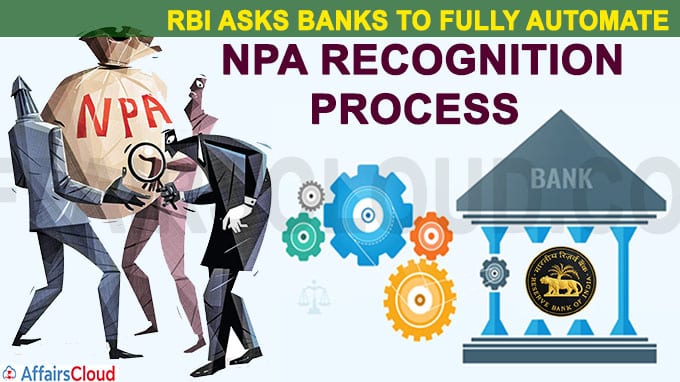 In August 2011, the Reserve Bank of India (RBI) issued circular advising banks to switch to automatic identification of non-performing assets (NPAs), using appropriate IT (information technology) systems, from manual identification for regulatory reporting and bank’s own management information system (MIS) requirements. However, over this period of time, the processes for NPA identification, income recognition, provisioning and generation of related returns in many banks are not yet fully automated.
In August 2011, the Reserve Bank of India (RBI) issued circular advising banks to switch to automatic identification of non-performing assets (NPAs), using appropriate IT (information technology) systems, from manual identification for regulatory reporting and bank’s own management information system (MIS) requirements. However, over this period of time, the processes for NPA identification, income recognition, provisioning and generation of related returns in many banks are not yet fully automated.
- Concerning this, on September 14, 2020, RBI issued a notification mandating banks to complete the automation of bad-loan recognition and provisioning processes by June 30, 2021. In case of non-compliance, suitable supervisory action would be initiated against the concerned bank.
Key Points:
-Accounts Coverage: All borrower accounts, including temporary overdrafts, irrespective of size, sector or types of limits, should be covered in the automated IT-based system for asset classification.
–Calculation of provisioning requirements shall also be System based as per pre-set rules captured in the System.
–Income recognition or derecognition of impaired assets will also be system driven.
–The System will handle both down-grade and upgrade of accounts through Straight Through Process (STP) without manual intervention.
-Banks should also be able to generate classification status report at any given point of time with actual date of classification of assets as NPAs/Non-Performing Investments (NPI).
-Exception: RBI noted that banks should not resort to manual-intervention-based asset classification processes. However, in any exceptional circumstance where manual intervention is required, it must have at least two level authorization as per the board-approved policy of the bank. Such intervention is subjected to audit by concurrent and statutory auditors.
–In case a separate application outside the core banking system is used for NPA classification, the system must have access to the required data, and investment accounts should be updated back into the CBS (core banking solution) automatically.
Click Here for Official notification
Points to Recall :-
-In Public sector banks, Gross NPAs reduced from Rs 8.96 lakh crore in March-2018 to Rs 6.78 lakh crore in March-2020.
-According to the Financial Stability Report released by the Reserve Bank of India (RBI) on July 2020, the Central Bank predicts that the Gross Non Performing Assets (GNPA) ratio of all scheduled Commercial Banks (SCBs) may increase from 8.5 per cent in March 2020 to 12.5 per cent by March 2021.
-If the Macroeconomic environment gets affected further due to pandemic then the ratio of GNPA may further climbs to 14.7 per cent.
Points to be Noted:
Non-Performing Asset (NPA) :-
An asset which includes leased asset becomes non-performing when it stops to make income for any financial organisation or banks.A ‘non-performing asset’ (NPA) was defined as a credit facility in respect of which the interest and/ or instalment of principal has remained as ‘past due’ for a specified period of time.
A loan is classified as Non-Performing Asset when it is not being reimbursed by the borrower and couldn’t generating income for the lender or bank because of the unpaid interest by the borrower. In such a case, the loan is considered “in arrears” or “Outstanding”.
In general, loans become NPAs when they are outstanding for 90 days or more.
Sub-Classifications for Non-Performing Assets (NPAs)
Borrower will receive a grace period before classifying an asset as non-performing. Later, bank will categorize the NPA into one of the following sub-categories:
- Standard Assets – normal risk level, past due for anywhere from 90 days to 12 months
- Sub-Standard Assets – significantly higher risk level, past due for more than 12 months. Banks usually assign a haircut (reduction in market value) to such NPAs because they are less certain that the borrower will eventually repay the full amount.
- Doubtful Debts – past due for at least 18 months. This class of NPA seriously affects the bank’s own risk profile.
- Loss Assets – non-performing assets with an extended period of non-payment. With this class, banks are forced to accept that the loan will never be repaid, and must record a loss on their balance sheet.
Borrower Account means a demand, time or deposit account maintained by the Borrower at the Bank or other financial institution selected by the Borrower.
Recent Related News:
On August 12, 2020, RBI mandated the urban co-operative banks (UCBs) with assets of Rs 2,000 crore or above as on March 31, 2020 to implement system-based asset classification from 30 June 2021. For UCBs having total assets of Rs 1000 crore or above but less than Rs 2000 crore as on March 31, 2020 and have self-assessed under Level III or Level IV on “Comprehensive Cyber Security Framework for Primary(Urban) Cooperative Banks (UCBs) – A Graded Approach” are mandated to implement it from September 30, 2021.
About Reserve Bank of India (RBI):
Headquarters– Mumbai, Maharashtra
Formation– 1 April 1935
Governor– Shaktikanta Das
Deputy Governors– 4 (Bibhu Prasad Kanungo, Mahesh Kumar Jain, Michael Debabrata Patra, one is yet to be appointed)



